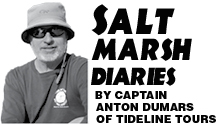 Tangier Islanders mostly crab for a living. Small wooden crab shacks, built on stilts above the shallow bay, huddle about the east-west channel on the north end of Tangier. One or several workboats float (or flounder) alongside each crab shack. Below a church steeple and water tower, white houses crowd the tiny land mass. Sailing from Onancock, we had thoughts of tying up at Tangier Island for the night. But all Tangier offered were strong currents, bare pilings, and ragged docks. Pleasure vessels had no place there.
Tangier Islanders mostly crab for a living. Small wooden crab shacks, built on stilts above the shallow bay, huddle about the east-west channel on the north end of Tangier. One or several workboats float (or flounder) alongside each crab shack. Below a church steeple and water tower, white houses crowd the tiny land mass. Sailing from Onancock, we had thoughts of tying up at Tangier Island for the night. But all Tangier offered were strong currents, bare pilings, and ragged docks. Pleasure vessels had no place there.
Tangier Island makes up the southern-most landmass along a central Chesapeake strand of low-lying islands and marshes. Of the island’s 740 total acres, habitable land amounts to 84 acres. Maximum elevation tops out at 4 feet above sea level. White folks from southwest England began living on Tangier Island in the 1680s. Descendants of these settlers make up much of the present-day population of about 700.
Tangier is among several disappearing land masses within the Chesapeake. Within a few generations, due to global sea level rise and land subsidence, these islands will become uninhabitable. Just like populations in Bangladesh, the Maldives, and South Louisiana (and many other troubled areas), residents of Tangier see this accelerating change with their own eyes.
Since 1850, the island has lost 67 percent of its landmass. Islanders didn’t cause the land to sink, nor did they contribute much to climate change. Knowing who or what caused this problem doesn’t change their predicament. They’re just stuck with it. Mitigation is not a viable option. Adaptation is the only option. In this case, adaptation means abandonment.
We turned Spartina around near Parks Marina, then headed back out of the harbor. Workboats of all sizes moved about us. A ferry full of tourists, heading in to Tangier Island, passed us in the narrow channel. Old men, standing on crooked docks, worked over soft-shell crab pins. Life continued. As we sailed away to the east, I turned to watch Tangier’s water tower sink into the horizon.
Capt. Anton DuMars, longtime Folly resident and coastal geologist, spent the summer visiting marshes in coastal North Carolina and the Chesapeake Bay. He loves your feedback. Contact Anton here: sailspartina@gmail.com

